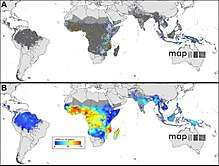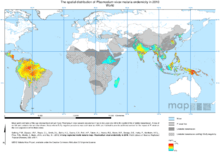Malaria Atlas Project
The Malaria Atlas Project, abbreviated as MAP, is a non-profit academic group led by Professor Peter Gething, Kerry M Stokes Chair in Child Health, at the Telethon Kids Institute, Perth, Western Australia. The group is funded by the Bill and Melinda Gates Foundation, with previous funding also coming from the Medical Research Council and the Wellcome Trust. MAP aims to disseminate free, accurate and up-to-date information on malaria and associated topics, organised on a geographical basis. The work of MAP falls into three areas:
- The estimation of the spatial distribution of malaria prevalence and incidence and related topics such as the spatial distribution of insecticide treated nets, antimalarial drugs, mosquito vectors, and human blood disorders
- Disseminating data on malaria via the Repository for Open Access Data (ROAD-MAP) project
- Providing maps relating to malaria prevalence and related topics for the World Health Organization (WHO) and other bodies.
 | |
| Abbreviation | MAP |
|---|---|
| Formation | May 1, 2006[1][2] |
| Purpose | Determining spatial limits of Plasmodium falciparum and Plasmodium vivax malaria at a global scale and its endemicity within this range |
| Headquarters | Oxford, UK |
Region served | Global |
Official language | English |
Head of Group | Professor Peter Gething |
Parent organization | University of Oxford |
| Website | https://www.map.ox.ac.uk/ |
The MAP team have assembled a unique spatial database on linked information derived from medical intelligence, satellite-derived climate data to constrain the limits of malaria transmission,[3] and the largest ever archive of community-based estimates of parasite prevalence.[4] These data have been assembled and analysed by a team of geographers, statisticians, epidemiologists, biologists and public health specialists. Furthermore, where these data have been cleared for release, they are available via a data explorer tool on the MAP website.
History
MAP was founded by Bob Snow and Simon Hay in 2005 to fill the niche for the malaria control community at a global scale. Between 2012 and 2015, it was led by Peter Gething, Dave Smith, Catherine Moyes and Simon Hay. The initial focus of MAP centred on predicting the endemicity of Plasmodium falciparum,[5] the most deadly form of the malaria parasite, due to its global epidemiological significance and its better prospects for elimination and control. Work in 2009 began to map the extent and burden of the relatively neglected Plasmodium vivax.
The Repository for Open Access Data from the Malaria Atlas Project (ROAD-MAP) was established by Catherine Moyes, Simon Hay and Bob Snow in 2011. Between 2014 and 2019, it was led by Peter Gething and Mike Thorn.
Academic research
Modelling malaria prevalence
A key aspect of MAP’s work is to use statistical approaches to modelling the prevalence of different forms of malaria on a global scale using Bayesian model-based geostatistics.[6]
Various environmental factors are known to affect malaria prevalence. Malaria prevalence is known to vary in a relatively predictable fashion in space and time, and observed malaria prevalence depends heavily on people’s age and intervention coverage.
In spatial epidemiology, it is common to find that very few measurements have been taken in large parts of the geographical region of interest. The available measurements may be error-prone or incompletely reported, and almost always it is a subset of the local population that has been surveyed.
Since 2005, MAP has collated an extensive database of survey data from a variety of sources. These surveys are typically clustered at village level and record data on parasite positivity rates, usually determined by rapid diagnostic blood tests. Additionally, MAP has gathered extensive data on covariates such as temperature suitability and land cover. These factors affect the distribution of the mosquito vectors responsible for spreading malaria.
The benefit of using Bayesian model-based geostatistics is that it conveys the spatially varying level of uncertainty associated with the mapped surface.
The probability that any of the very many individual (candidate) maps is the single correct map is small, so it is not useful to report the single most likely map. Taken together, however, the candidate maps make it possible to compute the probability of correctness of statements about the map, such as Plasmodium falciparum endemicity at location x in 2010 was between 0.1 and 0.3".
Plasmodium falciparum prevalence maps
Since the year 2000, a concerted campaign against malaria has led to unprecedented levels of intervention coverage across sub-Saharan Africa. Future control planning depends on understanding the effect of this effort. However, the effect of malaria interventions across the varied epidemiological settings of Africa remains poorly understood owing to the absence of reliable surveillance data and the simplistic approaches underlying current disease estimates.
In September 2015, research by MAP published in Nature quantified the attributable effect of malaria disease control efforts in Africa. The results showed Plasmodium falciparum infection prevalence in endemic Africa halved and the incidence of clinical disease fell by 40% between 2000 and 2015. The best estimate is that interventions have averted 663 million clinical cases since 2000. Insecticide-treated nets, the most widespread intervention, were by far the largest contributor. Although still below target levels, current malaria interventions have substantially reduced malaria disease incidence across the continent.[7][8]

Plasmodium vivax prevalence maps
In 2012, MAP published the first global maps for Plasmodium vivax endemicity.[4]

Data collection, curation, and dissemination
WHO World Malaria Reports
The MAP team works in collaboration with the World Health Organization (WHO) to provide the prevalence estimates for sub-Saharan African countries for the annual World Malaria Report. Additionally, MAP aids the WHO in production of the annual prevalence rates maps in the World Malaria Report.
Ongoing data curation
The MAP database is the biggest source of processed malariometric data available.
By April 2015, the MAP database contained:
- 40,000 geo-referenced cluster locations’ parasite rate survey records from 2,010 sources
- The database contains approximately 50,000 Annual Parasite Incidence (hereafter API) records for the years 2002 – 2010.
MAP actively seeks out and curates a wide variety of additional data from different sources, including the following:
- Malaria intervention coverage indicator data
- Parasite rate data
- Annual Parasite Incidence data
- Treatment-seeking data
- Satellite data to provide covariate raster surfaces
- Blood disorder data
- Mosquito bionomics and distribution data
MAP is committed to the free and open dissemination of this data (where permission has been granted by the data owner to release it). Dissemination of data is facilitated via the main MAP webpage and the Explorer tool. The latter allows users to download tabular data on malaria by countries.
See also
- Center for Disease Dynamics, Economics & Policy
- The AfriPop Project
References
- Hay, Simon I; Snow, Robert W (December 5, 2006). "The Malaria Atlas Project: Developing Global Maps of Malaria Risk". PLOS Medicine. PLOS. 3 (12): e473. doi:10.1371/journal.pmed.0030473. PMC 1762059. PMID 17147467.
The MAP Web site (http://www.map.ox.ac.uk) was launched on May 1, 2006, to further the aims and ambitions of MAP.
- "MAP Researchers". Malaria Atlas Project. Retrieved January 9, 2017.
The Malaria Atlas Project (MAP) was founded in 2005
- Weiss, D.J.; Mappin, B.; Dalrymple, U.; Bhatt, S.; Cameron, E.; Hay, S.I; Gething, P.W. (7 February 2015). "Re-examining environmental correlates of Plasmodium falciparum malaria endemicity: a data-intensive variable selection approach". Malaria Journal. 14 (68): 68. doi:10.1186/s12936-015-0574-x. PMC 4333887. PMID 25890035.
- Gething, P.W.; Elyazar, I.R.F.; Moyes, C.M; Smith, D.L.; Battle, K.E.; Guerra, C.A.; Patil, A.P; Tatem, A.J.; Howes, R.E.; Myers, M.F.; George, D.B.; Horby, P.; Wertheim, H.F.; Price, R., Müller.I; Baird, J.K.; HAY, S.I (6 September 2012). "A long neglected world malaria map: Plasmodium vivax endemicity". PLoS Neglected Tropical Diseases. 6 (9): e1814. doi:10.1371/journal.pntd.0001814. PMC 3435256. PMID 22970336.
- Gething, P.W; Patil, A.P; Smith, D.L.; Guerra, C.A.; Elyazar, I.R.F.; Johnston, G.L.; Tatem, A.J.; Hay, S.I (20 December 2011). "A new world malaria map: Plasmodium falciparum endemicity in 2010". Malaria Journal. 10 (378): 378. doi:10.1186/1475-2875-10-378. PMC 3274487. PMID 22185615.
- Patil, Anand P.; Gething, Peter W.; Piel, Frédéric B.; Hay, Simon I. (2011). "Bayesian geostatistics in health cartography: The perspective of malaria". Trends in Parasitology. 27 (6): 246–253. doi:10.1016/j.pt.2011.01.003. PMC 3109552. PMID 21420361.
- Bhatt, S.; Weiss, D. J.; Cameron, E.; Bisanzio, D.; Mappin, B.; Dalrymple, U.; Battle, K. E.; Moyes, C. L.; Henry, A. (Oct 2015). "The effect of malaria control on Plasmodium falciparum in Africa between 2000 and 2015". Nature. 526 (7572): 207–211. doi:10.1038/nature15535. PMC 4820050. PMID 26375008.
- "Millions of children's lives saved as malaria deaths plunge: U.N." Reuters. 2015-09-16. Retrieved 2015-12-09.
External links
- Malaria Atlas Project — Official website